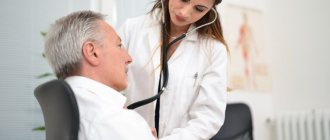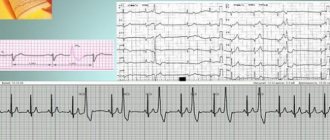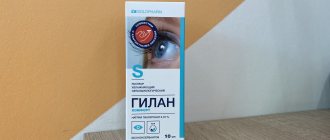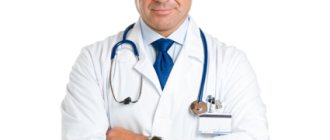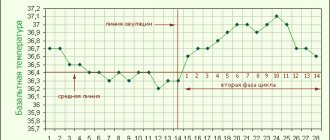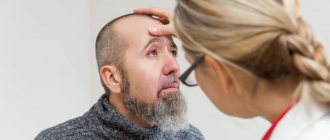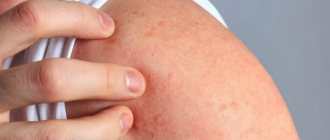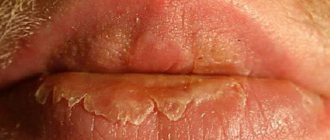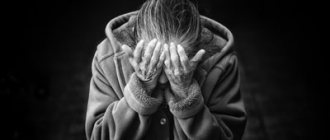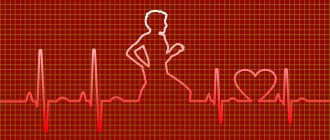Causes
NVEs develop due to many reasons.
Even a simple sneeze or fear can cause extraordinary contraction of the myocardium. The most common culprits of extrasystoles are various heart diseases: coronary disease, cardiomyopathy, congenital and acquired defects, myocarditis, pericarditis, chronic heart failure, etc. Also, supraventricular extrasystole develops with the following factors, conditions and diseases:
- violation of autonomic regulation (autonomous dysfunction syndrome);
- physical and emotional stress;
- neurotic disorders;
- reflex irritation of the cardiac nerves in diseases of the gastrointestinal tract: duodenal ulcer, cholelithiasis;
- presence of bad habits;
- coffee addiction;
- taking pills: antidepressants, psychostimulants to reduce appetite, vasoconstrictor nasal drops, medications for high blood pressure. Even some antiarrhythmic drugs in some cases cause EVE;
- infectious diseases;
- severe diseases of the respiratory system: bronchial asthma, chronic broncho-obstructive pulmonary disease;
- pathology of endocrine organs: Graves' disease, Hashimoto's thyroiditis, diabetes mellitus;
- excess or deficiency of minerals in the body (calcium, magnesium, sodium);
- chest injuries.
In some cases, the cause of the rhythm disturbance cannot be identified. Then a diagnosis of “NVE of unknown etiology” is made.
Classification and types
There are many types of NLEs, divided according to different characteristics.
Depending on the source of the impulse, atrial extrasystoles and extrasystoles (ES) from the atrioventricular (AV) connection are distinguished. Based on the number, they distinguish between single and double. Three or more ES in a row is already considered an episode of tachycardia (also called a “jog”).
In my patients, I often observe such an ECG phenomenon as allorhythmia - the regular occurrence of extrasystoles. There are the following types:
- bigeminy - the appearance of ES on the cardiogram after each normal contraction of the heart (read more about this phenomenon here)
- trigeminy - after every second complex;
- quadrigeminy - after every third complex.
Depending on the cause, the following types of NVEs are distinguished:
- functional - during physical activity, reflex effects;
- organic - for heart diseases;
- toxic - in case of drug overdose;
- mechanical - for injuries.
Single extrasystoles
The most benign variant of NVE, mainly found in healthy individuals, are single supraventricular extrasystoles. They almost always go unnoticed by humans and do not pose a threat to health.
Diagnosis and treatment of extrasystoles
Extrasystoles can be detected on an electrocardiogram, as well as during daily Holter monitoring. Rare extrasystoles do not require treatment if, after examining the patient, no heart disease is detected. If the examination reveals that the extrasystoles are associated with some other disease (diseases of the gastrointestinal tract, endocrine diseases, inflammatory diseases of the heart muscle), the underlying disease is treated.
The doctor should explain what the patient should avoid and what non-drug methods can alleviate the condition and relieve extrasystoles. It is very important that extrasystole caused by disorders of the nervous system and psycho-emotional overload is treated by prescribing sedatives or sedatives. In our age of stress, a properly selected sedative often completely relieves the patient of extrasystoles.
The prescription of antiarrhythmic drugs occurs with mandatory consideration of the types of extrasystoles and heart rate. The selection of antiarrhythmic drugs is made strictly individually and only by a doctor. Remember! All antiarrhythmic drugs have a proarrhythmic effect, that is, they themselves can cause or intensify arrhythmia.
Our doctors select medications based on the latest Russian and international recommendations. Moreover, they have the opportunity to select a drug under ECG control, and the patient does not have to constantly be in the cardiac center. For this we use a remote ECG analysis system. In addition, treatment is monitored using Holter monitoring on average once a month.
If the effect of the drug is good, extrasystoles disappear or are significantly reduced. As a rule, medications need to be taken continuously. In some cases, it is possible to discontinue the medication. But at the same time, the dose of the medication is gradually reduced over a long period of time, since abrupt discontinuation of treatment leads to the recurrence of extrasystoles.
Signs on ECG
Supraventricular extrasystole is very easy to recognize on a cardiogram. Main features:
- extraordinary (extrasystolic) appearance of a pathological deformed P wave and the following unchanged QRST complex;
- the presence of a compensatory pause, i.e. a straight line on the film.
If the P wave has a different shape in different leads, this phenomenon is called polytopic atrial extrasystole. Its detection is highly likely to indicate a heart or lung disease and requires a more thorough diagnosis.
It happens that after an extraordinary P wave there is no QRST complex. This happens when atrial extrasystole is blocked. ES from the atrioventricular junction differs in that the P wave is negative or not recorded at all due to overlap with the T wave.
When taking an ECG at rest, extrasystoles may not be detected. Therefore, in order to “catch” them and find out how often they occur, I prescribe Holter monitoring to my patients. In case of concomitant diseases, a person undergoes a cardiac ultrasound (EchoCG).
After supraventricular ES, the pause lasts less than with ventricular ES.
What is characteristic of vegetative-vascular dystonia
It is important for a VSD patient to understand that his arrhythmia is of a functional nature. And no matter where exactly and in what quantity it occurs, one thing is clear: the heart is healthy, and the reason lies in something completely different.
Extrasystole in such patients manifests itself when a large amount of adrenaline enters the blood. But as soon as it decreases to normal, all sensations subside. That is, the problem is temporary and reversible. But patients tolerate it very hard. For them, this is like death: heart failures catch them suddenly, they can be repeated for several months and even years, until the cause is eliminated.
At this moment, a person is seized by a feeling of fear. He begins to choke, his legs give way, and he may lose consciousness. The patient becomes pale, begins to rush about, and scream. The sensation in the chest resembles a blow to the rib cage.
An even greater fear is the compensatory break after an extraordinary compression. The patient fears that his heart will stop. It seems to him that he will die, and this cannot be avoided.
If the excitement intensifies, then the symptoms worsen. Atrial fibrillation occurs. It seems that the heart works outside the regime, chaotically, as it pleases. Fortunately, this condition rarely occurs.
Treatment: when, how and with what
Supraventricular extrasystoles are almost always benign. If extraordinary contractions of the heart are single, are not accompanied by any symptoms and do not provoke the occurrence of severe rhythm disturbances, treatment of supraventricular extrasystole is not required. The main thing is to fight its cause.
When EVE worsens the patient's condition, I prescribe drug therapy. The most effective drugs for stopping SE are beta-blockers - Bisoprolol, Metoprolol. If there are contraindications to their use (for example, severe bronchial asthma), I transfer the patient to slow calcium channel blockers - Verapamil, Diltiazem. Read about how extrasystole is treated with medications here.
As for traditional methods, to date there is no convincing evidence of their effectiveness. In my practice, I recommend that patients under no circumstances replace traditional treatment with traditional medicine. But if you have a different opinion, we invite you to read the material here.
If the development of NVE is associated with emotional stress or a neurotic disorder, you can take sedatives and make an appointment with a psychotherapist.
The main criteria for the success of therapy are the cessation of symptoms and normalization of the patient’s condition.
In rare cases, when drug treatment does not have the expected positive effect, surgical intervention is used, in particular, a technique such as radiofrequency catheter ablation. I usually prescribe this operation to young patients, since with age the risk of developing severe complications, including death, increases.
It is extremely rare, for health reasons, that an open access operation is performed, with dissection of the chest and removal of the portion of the myocardium where extraordinary impulses are formed.
Indications for treatment and its methods
It is important to note that in the vast majority of cases, in order to stop extraordinary contractions of the heart, you only need to eliminate the cause.
Special drug treatment of atrial extrasystole is required only in the following situations:
- PE occurs constantly and in large numbers;
- there are accompanying symptoms that worsen the patient’s condition;
- development of severe heart rhythm disturbances against the background of PE;
- progression of the underlying cardiac disease due to PE.
To start using special pharmacological drugs, 1 criterion is sufficient.
Among the medications for the treatment of PE, beta-blockers are considered to be the most effective - Metoprolol, Bisoprolol. They reduce the excitability of the heart muscle and are able to suppress the conduction of pathological nerve impulses that provoke PE.
But, unfortunately, these drugs are not suitable for everyone. If a person suffers from bronchial asthma, or has chronic obstructive pulmonary disease due to long-term smoking, beta blockers can cause bronchospasm, which will lead to difficulty breathing. Therefore, such patients are shown calcium channel blockers - Diltiazem, Verapamil.
For patients who have developed atrial extrasystole due to stress, I prescribe sedatives. Often you can get by with herbal preparations (valerian, motherwort). In case of severe neurotic disorders, it is necessary to use strong sedative medications - Diazepam, Phenazepam.
According to the treatment protocol, if drug therapy is unsuccessful, I refer the patient to cardiac surgeons who perform a special operation - radiofrequency ablation (RFA). With RFA, foci of pathological excitation waves are destroyed by exposure to high-frequency current.
Why are supraventricular extrasystoles dangerous and what are their consequences?
Extraordinary supraventricular extrasystoles themselves do not pose a threat to human life and often go unnoticed. However, they can provoke the appearance of more severe rhythm disturbances: supraventricular tachycardia, atrial fibrillation and flutter, which lead to a sharp decrease in blood pressure, deterioration of blood supply to the myocardium and an increased risk of blood clots in the heart. A combination is often observed .
Long-term polytopic and blocked ES are considered the most unfavorable.
The consequences of supraventricular extrasystole are determined by the presence of: coronary heart disease, chronic heart failure, etc. The rhythm disturbance itself almost does not cause any complications.
Features of treatment with folk remedies
It is not always necessary to use antiarrhythmic medications. Treatment of extrasystole with folk remedies also gives good results. There are many medicinal plants that help fight arrhythmias:
calendula – contains large amounts of magnesium and potassium, antioxidants. Calendula infusion brings the rhythm back to normal, improves blood supply to the myocardium;- lemon balm – rich in microelements, has calming, restorative properties, reduces blood pressure;
- hawthorn – contains a large amount of magnesium, has tonic and antiarrhythmic properties, improves coronary blood flow;
- Adonis (Adonis) – contains many cardiac glycosides, due to which it has a cardiotonic effect and restores normal heart rhythm. Contraindicated for gastrointestinal diseases.
- cornflower – has pronounced antiarrhythmic and antispasmodic effects, which makes it good at relieving attacks of extrasystole.
In any case, before using any medicines, even traditional ones, consult your doctor. After all, even herbal medicines can have contraindications.
Expert advice
Despite the fact that most often EVEs are relatively harmless, if they occur frequently and are accompanied by symptoms (feelings of freezing, interruptions in heart function, dizziness, feeling of lightheadedness), you should consult a doctor to find out the cause, including examination for cardiac problems. and other diseases. I try to explain to my patients that eliminating the causative factor is of no small importance in the treatment of EVE. Therefore, I give recommendations for lifestyle changes: you need to quit smoking, try to avoid severe stress, and significantly limit the consumption of alcohol and coffee. If a person develops signs of EVE while taking medications, be sure to tell the doctor about it. Reducing the dosage or changing the medication often helps get rid of extrasystoles.
Supraventricular arrhythmia
Any disturbances in the regulation of cardiac activity affect the functioning of the entire body. Thus, dangerous functional heart diseases include arrhythmia, which occurs due to changes in the rhythm of myocardial contractions. Supraventricular arrhythmia occurs in patients of any age and is often asymptomatic. To prevent complications of this pathology, drug and surgical treatment may be required.
What is supraventricular arrhythmia?
Arrhythmia is any disturbance in the natural rhythm of heart contractions. As a rule, we are talking about a rapid, inconsistent or slow rhythm of contractions. Further classification of the disease depends on the location of the pathological rhythm and the form of its course. In case of supraventricular arrhythmia, the lesion is located in the upper parts of the heart, the atria.
The heart is the only muscular organ in the body capable of continuous heavy work. A thick layer of heart muscle, called the myocardium, contracts rhythmically to transport blood from the organ's internal chambers to every cell in the body through blood vessels. Strict regulation of myocardial activity not only ensures the preservation of muscle structures, but also maintains the constancy of hemodynamics.
The heart has short periods of activity and rest. During the period of activity, the muscles contract and push blood into the vessels or adjacent chambers. A rest period is necessary for passive filling of the organ section with blood. If the heart muscle contracted without interruption, the cells would not receive the required amount of blood, and the vessels would remain empty. That is why external and internal regulatory factors maintain a constant speed, frequency and sequence of contractions. With arrhythmia, this mechanism is disrupted, causing the heart to work ineffectively.
Thus, supraventricular arrhythmias, the classification of which can be quite arbitrary, cause any disorders of cardiac activity within the atria.
8
24/7
Forms of pathology
Pathological supraventricular arrhythmias alter cardiac activity in various ways. The modern classification includes the following forms of the disease:
- Atrial fibrillation. The pathology is characterized by a sharp violation of the sequence and frequency of contractions of the myocardium of the upper parts of the heart. The efficiency of the pumping function is quite low, which is why blood cannot be completely transported to the lower part of the organ and arteries. This is the most common form of the disease, which has been diagnosed at least once in 85% of people over 65 years of age.
- Premature atrial contraction (extrasystole). After a single contraction of the myocardium, a period of rest, diastole, normally begins. With extrasystole, an additional impulse occurs in the muscle tissue of the organ, provoking a rhythm disturbance. This is a benign form of arrhythmia that rarely causes dangerous complications in patients.
- Supraventricular tachycardia is an increase in the frequency of contractions of the atrial myocardium. Normally, the heart contracts from 60 to 100 times per minute, but with tachycardia the frequency often ranges from 100 to 240 beats. This form can occur in childhood and adolescence. With tachycardia, blood pressure decreases and the efficiency of blood supply to tissues decreases.
- Atrial flutter. The instability of myocardial contractions in this case is less dangerous than with fibrillation, however, one form of arrhythmia can gradually transform into another. The heart rate may increase to 200 or more beats per minute. The pathology usually occurs in elderly patients with primary cardiovascular diseases.
- Sinus supraventricular arrhythmia is a disorder of heart activity that occurs due to improper functioning of the pacemaker. The main function of the sinus node is to generate an electrical impulse in a certain rhythm. This impulse spreads from the sinus node to other parts of the organ’s myocardium along the conduction pathways and causes successive contractions. Sinus node syndrome is characterized by impulses that occur too frequently or too rarely.
Most of the listed disorders are dangerous not only because of the resulting lack of blood supply to the organs. Supraventricular arrhythmia changes the pattern of blood flow and provokes the formation of blood clots. This is why stroke is a common complication of the disease.
Causes
Supraventricular arrhythmia occurs against the background of damage to the sinus node and the conduction pathways of the upper heart. This disease can be caused by congenital and acquired organ defects.
Main causes and risk factors:
- Damage to the myocardium and pathways due to ischemia and infarction.
- Atherosclerosis and impaired tone of the coronary arteries, as a result of which the heart receives insufficient blood supply.
- Congenital heart defects.
- Damage to the heart valves and blood vessels.
- Congestive heart failure.
- Thyroid gland dysfunction.
- Infectious or toxic damage to the heart muscle.
- Complications of surgery.
- Consumption of alcohol, caffeine and drugs.
- Side effects of medications.
- Obesity, smoking and sedentary lifestyle.
- High blood pressure.
- Lung diseases.
Doctors are not always able to determine the exact cause of the disease. Supraventricular arrhythmia of unknown etiology is often diagnosed in adolescents and is predominantly asymptomatic. In rare attacks, the arrhythmia itself, supraventricular extrasystole and other forms of cardiac dysfunction do not significantly affect the patient’s quality of life.
Symptoms
Supraventricular arrhythmia does not differ in the constancy of its symptomatic and clinical picture. Depending on the form and frequency of attacks of the disease, the patient may only occasionally experience mild discomfort or constantly suffer from acute disturbances in the blood supply to the organs. Thus, paroxysmal supraventricular arrhythmia and fibrillation have the most pronounced symptoms, while extrasystole is usually characterized by a mild course.
8
24/7
Possible symptoms and signs:
- Sharp chest pain and palpitations.
- Breathing problems.
- Weakness and dizziness.
- Impaired consciousness, fainting.
- Sweating.
- Muscle weakness.
- Anxiety and stress.
If complications arise against the background of arrhythmia, the symptoms become more intense. With congestive heart failure, patients may experience swelling of the extremities.
Diagnostics
If symptoms appear that indicate an irregular heartbeat, you should consult a physician or cardiologist. The doctor may suspect the disease even at the stage of clarifying complaints and studying the anamnesis, since arrhythmia is a characteristic complication of many primary diseases of the cardiovascular system. Further diagnostic tactics include instrumental studies and laboratory tests.
Diagnostic methods:
- Electrocardiography is the study and recording of the electrical activity of the heart using special sensors. The results of the study make it possible to identify any heart rhythm disturbances that arise during the process of obtaining a cardiogram. However, the method is ineffective for diagnosing hidden arrhythmia.
- A Holter study is a recording of a cardiogram for 24 hours or longer using a portable device placed on the patient’s body. The advantage of the method is that the patient is engaged in normal activities, and the device records any violations. Doctors do not need to analyze the complete cardiogram record, since the patient notes the time of occurrence of attacks of the disease. This is the optimal way to diagnose hidden arrhythmia.
- Echocardiography is a visual examination of the heart based on ultrasound. During diagnosis, the doctor sees the image of the heart on the monitor and evaluates its performance. The method allows you to detect the root cause of arrhythmia. Sometimes it is necessary to place a probe in the esophagus for a more accurate diagnosis.
- Bicycle ergometry is a study of the electrical activity of the heart (ECG) during physical activity. There are often cases when supraventricular arrhythmia manifests itself only against the background of increased muscle load. Thus, this method is also aimed at diagnosing the latent form of the disease.
- Angiography is a visual examination of the heart vessels to detect the cause of arrhythmia. The doctor injects a contrast agent into a vein and obtains an image of the heart's vessels using a scan. In this way, disturbances in the blood supply to the heart muscle are detected.
- Computed tomography and magnetic resonance imaging are modern methods of organ imaging necessary for detecting small and large lesions. In cardiology it is also used to diagnose the cause of arrhythmia.
- Blood analysis. A test for enzymes and hormones can detect myocardial infarction or thyroid pathology.
The use of several examination methods increases the accuracy of diagnosis and the effectiveness of subsequent treatment.
Treatment and prevention
Chronic supraventricular arrhythmias, extrasystoles and other forms of cardiac arrhythmia may require medical and surgical treatment. The main goal is to stop attacks, permanently restore natural myocardial activity and prevent complications.
The main medicinal purpose is the group of antiarrhythmic drugs. These drugs are used during an attack for symptomatic treatment and on an ongoing basis. To prevent stroke, anticoagulants are prescribed to prevent the formation of blood clots. Glycosides and beta blockers that regulate heart activity are also used for treatment.
Surgical methods can be aimed at installing an artificial pacemaker or removing the source of arrhythmia in the myocardium. If the pacemaker normalizes the heart during an attack, then radical surgery can help completely get rid of the problem. Radiofrequency catheter ablation is the most effective and minimally invasive method of surgical treatment.
We should not forget that supraventricular arrhythmia, the treatment of which can be long and ineffective, can be prevented. If the patient already has primary heart disease, it is necessary to undergo regular examinations. Therapeutic diets, moderate exercise and giving up bad habits reduce the risk of arrhythmia. It is important to consult a doctor as soon as possible with suspicious symptoms and determine treatment and preventive tactics.
8
24/7
Clinical case
A 33-year-old man came to see me with complaints of rapid heartbeat, periodic sensations of “fading” and interruptions in heart function over the past 3 weeks. He does not take any medications on his own. Doesn't smoke, doesn't drink alcohol. A general examination revealed a high heart rate (105 beats per minute) and increased blood pressure - 140/80 mmHg. Art. During the conversation, I noticed the patient’s uncharacteristic irritability and bulging eyes. When questioning about the presence of diseases in relatives, the man noted that his father suffered from Graves' disease. Holter ECG monitoring was prescribed. Sinus tachycardia, atrial extrasystole of the bigeminy type, and a large number of single extraordinary contractions (967) were detected. A referral was issued to an endocrinologist to check the thyroid gland. On the recommendation of a specialist, an ultrasound examination was performed and blood was taken for hormonal tests. The results obtained: diffuse enlargement of the thyroid gland, decreased TSH levels, increased concentrations of free T4, high titers of antibodies to the TSH receptor. Diffuse toxic goiter was confirmed . Mercazolil therapy was prescribed with subsequent monitoring of hormone levels. To slow down the heartbeat and combat extrasystole, beta-blockers (Bisoprolol) are recommended.
Symptoms
The clinical picture of atrial extrasystole can be varied - from a completely asymptomatic course to severe hemodynamic disturbances. It all depends on the number of extrasystoles and the presence of organic heart pathology.
Single
If a person experiences a single atrial extrasystole, he often does not even suspect it, since he feels well and nothing bothers him. Such extrasystoles are detected by chance during a preventive medical examination.
Only occasionally can there be a momentary sensation of “freezing” or “turning over” of the heart. The general well-being does not suffer in any way.
Frequent
It’s a completely different matter when it comes to the number of extrasystoles exceeding 200 per day. The above symptoms occur almost constantly. A person notices an irregular pulse. There is a feeling of anxiety and fear. There may be short-term darkening in the eyes, flashing of flies in front of them, dizziness, nausea, and difficulty breathing.
Patients who have cardiac diseases experience heart pain, increased shortness of breath, and lightheadedness. Loss of consciousness is also possible due to deterioration of the blood supply to the myocardium and a decrease in blood pressure.
